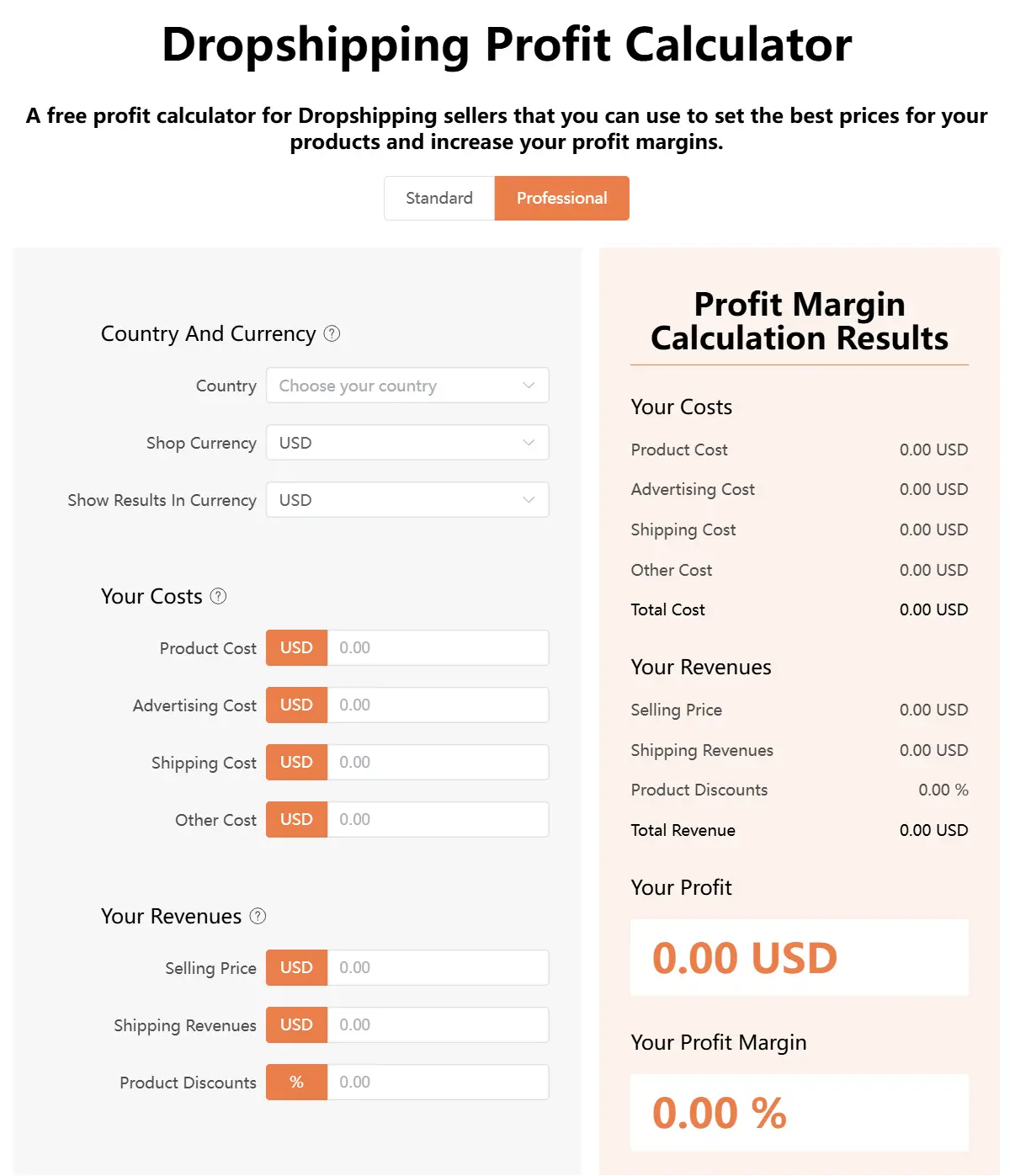Dropshipping Profit Calculator
A free profit calculator for Dropshipping sellers that you can use to set the best prices for your products and increase your profit margins.
Country And Currency
Country
Shop Currency
Show Results In Currency
Your Costs
Product Cost
USD
Advertising Cost
USD
Shipping Cost
USD
Other Cost
USD
Your Revenues
Selling Price
USD
Shipping Revenues
USD
Product Discounts
%
Profit Margin Calculation Results
Your Costs
Product Cost
0.00 USD
Advertising Cost
0.00 USD
Shipping Cost
0.00 USD
Other Cost
0.00 USD
Total Cost
0.00 USD
Your Revenues
Selling Price
22.05 USD
Shipping Revenues
0.00 USD
Product Discounts
0.00 %
Total Revenue
22.05 USD
Your Profit
0.00 USD
Your Profit Margin
0.00 %
Press CMD/CTRL+D Add Bookmark
How to Calculate Dropshipping Profit?
When starting a new direct sales business, it is important to have a clear understanding of its profit margins. Profit margin is a measure of the profitability of a business or product; the higher the margin, the more profitable the business or product. It can help you develop strategies that will increase profits over time and assist in business expansion.
The Importance of Dropshipping Profit Calculator
The Direct Sales Profit Calculator is a tool to calculate profit margins for your direct sales business. Use a simple formula to calculate profit margins. It can help you:
1. calculate the costs associated with manufacturing and shipping your products
2. determine the selling price and markup percentage of your merchandise
3. ensure that your company remains financially successful
4. consider other costs such as paying gateway fees, marketing expenses and taxes

What Is A Good Profit Margins for Online Dropshipping?
A good profit margins for online dropshipping can range between 15%-35%. However, it depends on your market niche, product quality, cost of goods, demand and market structure. If you sell low cost products or are in a highly competitive industry, then your profit margins will be lower than if you are in a niche industry. Here the demand is more as there are fewer competitors and hence you can make high profits.
What Is The Profit Margin Formula?
The profit margin formula determines the percentage of profit earned on each sale. Profit margin is calculated by dividing gross margin by net revenue and multiplying by 100. The formula gives you an idea of the profitability of your business and can guide pricing decisions for sustainable growth.
Profit Margin = (Gross Profit/Net Revenue) x 100

How To Calculate Profit Margin?
To calculate your profit margin, use the Profit Calculator and follow these steps:
1. Enter your cost of goods: Enter the total cost of each item you want to sell. This includes production costs, material costs and any costs associated with making the product.
2. Determine your pricing: You will need to enter the selling price of the item and the discounts at which you can price it to ensure that you recoup your costs, make a set profit and remain competitive.
3. Calculate your profit: Once you have entered your information, we will calculate the interest rate and margin in real time, and you will be able to set an optimum selling price for your product based on the calculated margin.
How To Get Good Profit Margins?
Good profit margins depend on your industry, business model and market conditions. Typically, the higher the margin, the better and more efficient the financial position.
Lower margins may be the norm for industries with high operating costs or high competition. Conversely, industries with unique products or services and less competition may have higher profit margins. In order to increase profit margins, strategies such as unique niches, optimising online shops to increase conversion rates and effective marketing plans to retain customers should be developed, while building strong relationships with distributors and managing shipping costs can also increase profit margins, in addition to effective marketing strategies such as advertising, increased resources or software.
While there's no one-size-fits-all answer, it's necessary to compare your margins to industry benchmarks and competitors to see exactly how you're performing. Additionally, consider factors such as your business growth goals, market share, and overall financial stability when evaluating your margins.

Frequently Asked Questions
Unleash the Profit Potential.
Getting Higher Profits.
Completely Free !
Start for Free